Feature Article
"The Big One"
Note: This article features several "thumbnail"
photographs. Click on any photo for a detailed view and the caption.
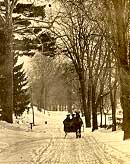 With
the mild winter of 1997-1998 and the current winter relatively mild so far,
thoughts of snowstorms, blizzards, nor-easters, and the like are pushed behind
other concerns in our minds, like impeachment of our president and war in the
middle east. However, let a good heavy snowfall hit our streets and driveways
and weather will be the talk of the town!
With
the mild winter of 1997-1998 and the current winter relatively mild so far,
thoughts of snowstorms, blizzards, nor-easters, and the like are pushed behind
other concerns in our minds, like impeachment of our president and war in the
middle east. However, let a good heavy snowfall hit our streets and driveways
and weather will be the talk of the town!
We don't prepare for the seasons anymore; not in the way our ancestors did.
After all, we usually have a day or two to "stock up" when a storm
is imminent (just ask the grocery clerks!). In the "good old days",
Yorktowners grew much of what they consumed, and depended on their resourceful
nature to survive the unpredictable wrath of winter. Livestock, rather than
machines, was used for transportation and livelihood, and activities were planned
around the calendar to utilize the most Mother Nature had to give.
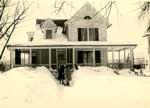 Everyone
remembers a "bad" winter, but there are only several blizzards that
have survived in infamy during the past two centuries. I was born in one of
them... the blizzard of '48 (that's 1948!). At least I was told I was born during
the blizzard. It seems that actually I was born 6 days after the snow stopped,
on a bitterly cold day.
Everyone
remembers a "bad" winter, but there are only several blizzards that
have survived in infamy during the past two centuries. I was born in one of
them... the blizzard of '48 (that's 1948!). At least I was told I was born during
the blizzard. It seems that actually I was born 6 days after the snow stopped,
on a bitterly cold day.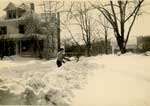 I discovered that fact while doing research for this article. I suspect that
the ravages of the previous month of winter weather were still being felt when
my mother delivered me; according to my parents, they had great difficulty getting
to the hospital only 2 blocks away (and my father was a policeman). The blizzard
of 1948 actually arrived on the New York scene on December 26th and 27th, 1947.
The weather reporting center in Bedford Hills recorded 32" of snow from
those two days, with another additional 19" accumulated by January 25,
1948 for a total of 51" in one month.
I discovered that fact while doing research for this article. I suspect that
the ravages of the previous month of winter weather were still being felt when
my mother delivered me; according to my parents, they had great difficulty getting
to the hospital only 2 blocks away (and my father was a policeman). The blizzard
of 1948 actually arrived on the New York scene on December 26th and 27th, 1947.
The weather reporting center in Bedford Hills recorded 32" of snow from
those two days, with another additional 19" accumulated by January 25,
1948 for a total of 51" in one month.
Thousands of people were stranded in New York City, tourists having visited
there for the holiday shopping and celebrations. The post-war baby boom was
in full swing, and no doubt many pregnant women delivered their babies in places
other than a hospital.
Another twentieth century storm took place in mid-March of 1956. Two separate
local newspaper accounts down-played the snowstorm due to it's timing...it was
compared to the March blizzard of 1888, probably the best known spring storm
of the nineteenth century.
The earliest record of local weather is from Bedford, NY 1894.* That April
they recorded 24" of snow from April 11-12th. In 1899, Bedford and Carmel,
NY were reporting, and recorded a major snowstorm in February of that year.
Bedford recorded 23" of snow from Feb. 12-14th and a total for the month
of 37".
A nineteenth century diary and scrapbook of newspaper clippings kept by Huldah
Townsend of Putnam County, and covered in an article in the Peekskill Star,
January 23, 1962, described the weather numerous times. One clipping read: "An
old gentleman residing in this place had an acquaintance, who in the year 1835,
rode to church seventeen successive Sundays in a sleigh. The same Winter, a
funeral procession crossed the ice from West Point to Cold Spring, on the 4th
day of April." In another clipping, a blizzard of 1892 was described
as the worst since the famous one of 1888.
The famous blizzard of 1888: replayed over and over again by local old timers;
the inspiration for the "Blizzard Men of 1888" (a club that used to
meet every year for over 50 years at the Hotel Pennsylvania, according to an
article in the Yorktown Herald, March 9, 1950); the "Big One".
It began after a bitterly cold January and February. The Peekskill Blade reported
on Yorktown Station, February 4, 1888 that "The thermometer has been
12 below Zero. Charles Darrow has badly frozen his feet, hands and ears. The
late snow storm will be something to be remembered here for a long time. The
obstruction to travel is not yet fully removed."
The coming of March must have seemed to the local farmers and townspeople like
a great weight would be lifted off them soon. Friday, March 9th was mild and
pleasant, according to Fred C. Warner, reporting in the Patent Trader on March
17, 1960. Then it happened. With no advanced forecast to watch on television,
winter food supplies (both animal and human) running low, and road conditions
poor from a previous storm, the worst remembered, deadly blizzard of a century
struck. With zero temperatures and 70 mph N.E. gales, the blizzard "was
the most damaging storm ever to hit this section of our country."
According to 20 year old Lena B. Evans of Croton Lake, recounted at the age
of 81, "the storm started Sunday, March 12 (correction: March
11th), about noon, light rain then snow, getting more heavy and dense. My
parents were both sick and I had to feed the horse and two cows. The barn was
about 400 feet from the house, as well as the chicken house....With a barrel
of flour, a pork barrel and hams, we had enough food. But many were short of
some foods."
From the old Highland Democrat came the following account by W.H.H. MacKellar:
"The 11th, 12th and 13th of March 1888, were three memorable days in
the history of the Hudson Valley. When people awoke on the morning of the 11th
a fine snow was falling and the wind whistled the tune of an ordinary storm.
Hour by hour it increased in violence. The snow drove before it like sand and
by noon of that day, people felt that a storm of the first magnitude was in
progress. Night fell and the fury of the gale was unabated. By the morning of
the 12th the blizzard had developed into a tragedy. News trickled in by telegraph
that miles of trains were stalled down the line of the New York Central Railroad
and that hundreds of people were imprisoned in those trains without food and
in some cases without heat. And all day long on the 12th the Arctic hurricane
raged and roared while the snow piled into drifts that covered every familiar
landmark, so that all localities looked alike. On the morning of the 13th the
storm was still raging but with declining severity and by evening the elements
finally gave over and calmed down during the night to clear weather."
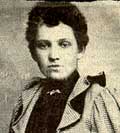 In
March of 1956, inspired by a recent spring snowstorm, Mrs. Emelie E. (Gilbert)
Maurer wrote her daughter the following letter about the Blizzard of '88: "I
remember looking out of my second story bedroom window over the top of the snow,
which was half way up the window panes. All I could see was snow and tree tops.
I have often wondered what they did with the snow that came out of all of the
tunnels...The men must have gotten out through the second story door, around
the huge snow drifts, somehow, and to the barn for shovels, and then dug their
way back to the house. There was a tunnel to the barn, and one to the hen house.
There was a family living just across the road (Hanover Road) from us. I think
it must have been several days before we got through to them, or they to us...I
do remember that we had to share our food supply with them.
In
March of 1956, inspired by a recent spring snowstorm, Mrs. Emelie E. (Gilbert)
Maurer wrote her daughter the following letter about the Blizzard of '88: "I
remember looking out of my second story bedroom window over the top of the snow,
which was half way up the window panes. All I could see was snow and tree tops.
I have often wondered what they did with the snow that came out of all of the
tunnels...The men must have gotten out through the second story door, around
the huge snow drifts, somehow, and to the barn for shovels, and then dug their
way back to the house. There was a tunnel to the barn, and one to the hen house.
There was a family living just across the road (Hanover Road) from us. I think
it must have been several days before we got through to them, or they to us...I
do remember that we had to share our food supply with them. 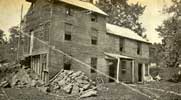 I
think our own food supply must have been getting low by that time, after the
long winter. I recall eating bread and molasses and nothing else for a long
time. The passenger train was snowed under on the long flat, between
Croton Lake and Yorktown. It took a week to get to the snow-buried train. People
worked frantically night and day and a few dropped dead from exhaustion. I do
not recall how many died on the train. The engineer died. The road from our
own place on Hanover Road to Yorktown was banked 40 feet high on the flats,
so it was probably April or May before we got through, but bread and molasses
kept us alive. (Jacob Maurer recalls a tunnel about 1,000 feet long from the
Major Andre house, south on Hanover Rd. This was dug out for the purpose of
getting farmers' milk to the milk train of 14 cars in Yorktown...)."
I
think our own food supply must have been getting low by that time, after the
long winter. I recall eating bread and molasses and nothing else for a long
time. The passenger train was snowed under on the long flat, between
Croton Lake and Yorktown. It took a week to get to the snow-buried train. People
worked frantically night and day and a few dropped dead from exhaustion. I do
not recall how many died on the train. The engineer died. The road from our
own place on Hanover Road to Yorktown was banked 40 feet high on the flats,
so it was probably April or May before we got through, but bread and molasses
kept us alive. (Jacob Maurer recalls a tunnel about 1,000 feet long from the
Major Andre house, south on Hanover Rd. This was dug out for the purpose of
getting farmers' milk to the milk train of 14 cars in Yorktown...)."
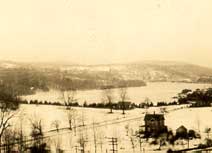 Warner
reported a train ramming a solid mass of snow at 30 mph telescoped "on
the Putnam Division at Yorktown" taking "the lives of two men".
He quoted Frank E. Hayt of Brewster: Hayt "tells us that 200 farmers
were unable to deliver their milk to the Borden creamery in Brewster. With every
available container filled with milk, they were finally compelled to cast hundreds
of gallons into the drifts of snow". (The first known frozen milk
shake!)
Warner
reported a train ramming a solid mass of snow at 30 mph telescoped "on
the Putnam Division at Yorktown" taking "the lives of two men".
He quoted Frank E. Hayt of Brewster: Hayt "tells us that 200 farmers
were unable to deliver their milk to the Borden creamery in Brewster. With every
available container filled with milk, they were finally compelled to cast hundreds
of gallons into the drifts of snow". (The first known frozen milk
shake!)
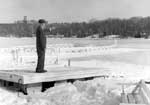 Judge
Enu Brown of Lake Mohegan recalled in 1956 his mother-in-law's story of the
Lake Mohegan Military Academy during the Blizzard of '88: "They had
at that time between 50 and 60 boys, and a standing order for meat placed with
Benjamin Curry, who operated, in addition to his church activities, a slaughter
house and butcher shop in Jefferson Valley.
Judge
Enu Brown of Lake Mohegan recalled in 1956 his mother-in-law's story of the
Lake Mohegan Military Academy during the Blizzard of '88: "They had
at that time between 50 and 60 boys, and a standing order for meat placed with
Benjamin Curry, who operated, in addition to his church activities, a slaughter
house and butcher shop in Jefferson Valley. 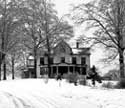 The
academy was practically out of food by the time the snow stopped, and the first
one to break a road through the drifts between Jefferson Valley and Mohegan
was Mr. Curry, driving a team of oxen drawing a sled loaded with beef. (Horses
were useless in the snow, because of the danger of breaking a leg.)"
The
academy was practically out of food by the time the snow stopped, and the first
one to break a road through the drifts between Jefferson Valley and Mohegan
was Mr. Curry, driving a team of oxen drawing a sled loaded with beef. (Horses
were useless in the snow, because of the danger of breaking a leg.)"
 Winter
wasn't all worry, whiteouts, and wind (say that 5 times fast)...
Winter
wasn't all worry, whiteouts, and wind (say that 5 times fast)... there
was fun, like sledding and snow-shoeing, building snow tunnels, skating and
racing on frozen lakes, ice fishing and of course for the children...no school!
Necessary chores such as ice harvesting, or cutting blocks of ice from lakes
using teams of horses pulling large saws, was a tradition often celebrated with
a winter picnic or supper. The cut blocks of ice were stored in usually large
"houses" made of stone or other well-insulated materials, between
layers of straw. This ice kept food fresh during the hot summer months before
electric refrigeration. Some farmers, like Benjamin Curry, had their own ponds.
Curry built a stone ice house nearby to keep his own blocks of ice handy.
there
was fun, like sledding and snow-shoeing, building snow tunnels, skating and
racing on frozen lakes, ice fishing and of course for the children...no school!
Necessary chores such as ice harvesting, or cutting blocks of ice from lakes
using teams of horses pulling large saws, was a tradition often celebrated with
a winter picnic or supper. The cut blocks of ice were stored in usually large
"houses" made of stone or other well-insulated materials, between
layers of straw. This ice kept food fresh during the hot summer months before
electric refrigeration. Some farmers, like Benjamin Curry, had their own ponds.
Curry built a stone ice house nearby to keep his own blocks of ice handy.

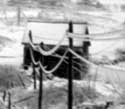 With
the exception of ice harvesting, most of the winter fun enjoyed by our ancestors
is still enjoyed today in Yorktown and neighboring communities.
With
the exception of ice harvesting, most of the winter fun enjoyed by our ancestors
is still enjoyed today in Yorktown and neighboring communities.
We will never prepare for winter the way our ancestors did, but like them,
we also will never know when the "Big One" will hit.
*National Weather Service Bureau records
Written by Linda L. Kiederer
Photos courtesy of the Town Clerk's Office
The Yorktown Historical Society updates the home page with seasonally appropriate
articles and information. Click here
to read our past issues.
 With
the mild winter of 1997-1998 and the current winter relatively mild so far,
thoughts of snowstorms, blizzards, nor-easters, and the like are pushed behind
other concerns in our minds, like impeachment of our president and war in the
middle east. However, let a good heavy snowfall hit our streets and driveways
and weather will be the talk of the town!
With
the mild winter of 1997-1998 and the current winter relatively mild so far,
thoughts of snowstorms, blizzards, nor-easters, and the like are pushed behind
other concerns in our minds, like impeachment of our president and war in the
middle east. However, let a good heavy snowfall hit our streets and driveways
and weather will be the talk of the town! 









